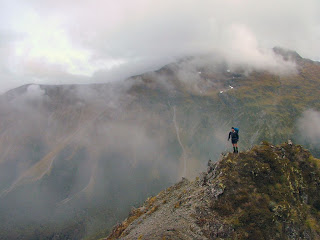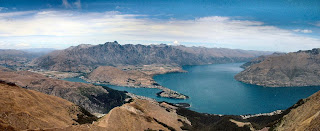At the top end of the St James Walkway, just off of the Lewis Pass are the Zampa Tops. Forming one side of the Cannibal Gorge, which the St James passes through they make an excellent weekend trip with the potential for an extended tops trip.
We headed up on the Friday night on the back of a so-so forecast for the Canterbury High Country and an excellent one for Nelson Lakes. We camped at Deer Valley on the first night and coincidently met some people who had just completed the tops themselves. They reversed the guidebook route, suggesting the climb up from Ada Pass was much easier than descending this way.

The first part of the route is on the St James Walkway, it was very different to last time we had been here in 2008 - then there was 6 inches of snow on the ground - today it was a mossy green colour. We headed down the St James to the Cannibal Gorge. The following information is given about the gorge:
Before the arrival of the European’s the route up the Maruia River, through Cannibal Gorge was well travelled and popular with Maori. Because of its rich wildlife and easy access to other areas including the greenstone found on the West Coast dispute over this access arose between Ngati Tumatakokiri of Buller / Nelson and the Ngai Tahu of Kaikoura. This dispute ended is grisly fashion when a party of Ngai Tahu were trapped in the gorge by the opposing tribe and later furnished the substance of a celebrity meal for the victorious Ngati Tumatakokiri – hence the name “Cannibal Gorge”
We reached the Cannibal Gorge Swing bridge after 20 minutes and dropped down to the river bank there before following the river upstream to the first major stream on the true left. This stream started off barren and desolate but climbed quite quickly and then narrowed. The bush closed in around it and it gained a lot of character.
At the scrub line we left the stream and climbed steeply on the left hand side to reach a grassy terrace well above the tops. We followed faint animal trails across a small saddle and without almost any height loss arrived at the Zampa Tarn.
This large tarn is fairly shallow and home to a large population of wild geese. We stopped for lunch here and enjoyed a brief spell of sunshine and warmth. There were plenty of semi sheltered camping spots nearby too.




From the tarn we climbed up and traversed the easy ridgeline north over several minor tops before finding a sheltered campsite in a well-drained hollow just off of Pt. 1681. Unfortunately our plans of enjoying a good sunset or sunrise were scuppered as the weather closed in at this point, though we did have the opportunity to see the Spencer Mountains before they disappeared in to the cloud and the route up the un-named stream to Nelson Lakes.
It rained on and off for most of the night; we had a wet tent to pack up the next morning. We descended directly down a spur from the last top to Ada Pass. One short section of this route around the 1500m contour is slightly airy, though not at all technically difficult. In mist finding the correct route would be hard as there are several false spurs dropping directly in to the stream to the north.



The bush bash wasn't bad at all except for the last 100m or so which had a lot of regrowth. We drifted left a lot during our descent and came out maybe 500m down from the Ada Pass Hut and had to mess about in the river bed for a couple of minutes.
The return route on the St James provided very quick travel. An hour or so saw us at Cannibal Gorge Hut where we stopped for a brief lunch and then another two hours of walking along the well-formed track saw us back at the Cannibal Gorge swing bridge. Inevitably the climb back up to the car park at the end seemed much longer than expected, but another 20minutes saw us comfortably back at the Lewis Pass car park.

The return route on the St James provided very quick travel. An hour or so saw us at Cannibal Gorge Hut where we stopped for a brief lunch and then another two hours of walking along the well-formed track saw us back at the Cannibal Gorge swing bridge. Inevitably the climb back up to the car park at the end seemed much longer than expected, but another 20minutes saw us comfortably back at the Lewis Pass car park.











